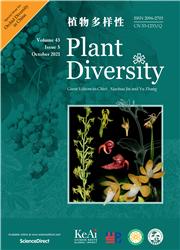Life forms affect beta-diversity patterns of larch forests in China
IF 4.6
1区 生物学
Q1 PLANT SCIENCES
引用次数: 0
Abstract
Beta-diversity reflects the spatial changes in community species composition which helps to understand how communities are assembled and biodiversity is formed and maintained. Larch (Larix) forests, which are coniferous forests widely distributed in the mountainous and plateau areas in North and Southwest China, are critical for maintaining the environmental conditions and species diversity. Few studies of larch forests have examined the beta-diversity and its constituent components (species turnover and nestedness-resultant components). Here, we used 483 larch forest plots to determine the total beta-diversity and its components in different life forms (i.e., tree, shrub, and herb) of larch forests in China and to evaluate the main drivers that underlie this beta-diversity. We found that total beta-diversity of larch forests was mainly dependent on the species turnover component. In all life forms, total beta-diversity and the species turnover component increased with increasing geographic, elevational, current climatic, and paleoclimatic distances. In contrast, the nestedness-resultant component decreased across these same distances. Geographic and environmental factors explained 20%∼25% of total beta-diversity, 18%∼27% of species turnover component, and 4%∼16% of nestedness-resultant component. Larch forest types significantly affected total beta-diversity and species turnover component. Taken together, our results indicate that life forms affect beta-diversity patterns of larch forests in China, and that beta-diversity is driven by both niche differentiation and dispersal limitation. Our findings help to greatly understand the mechanisms of community assemblies of larch forests in China.生命形式对中国落叶松森林贝塔多样性格局的影响
β -多样性反映了群落物种组成的空间变化,有助于了解群落的组成和生物多样性的形成与维持。落叶松(Larix)林是广泛分布于中国北部和西南山区和高原地区的针叶林,对维持环境条件和物种多样性至关重要。很少有研究对落叶松森林的β -多样性及其组成成分(物种更替和巢性-结果成分)进行研究。本文以483个落叶松样地为研究对象,对中国落叶松不同生物形态(乔木、灌木和草本)的总β多样性及其组成进行了分析,并对其主要驱动因素进行了评价。研究发现,落叶松森林的总β多样性主要依赖于物种更替分量。在所有生命形式中,总β -多样性和物种周转成分随着地理、海拔、当前气候和古气候距离的增加而增加。相反,巢性-结果分量在相同的距离上减小。地理和环境因子解释了总β多样性的20% ~ 25%,物种更替成分的18% ~ 27%,巢化-结果成分的4% ~ 16%。落叶松林类型显著影响总β多样性和物种周转分量。综上所述,生命形式影响着中国落叶松森林的beta多样性格局,并且beta多样性受生态位分化和扩散限制的双重驱动。研究结果有助于进一步认识中国落叶松群落聚集的机制。
本文章由计算机程序翻译,如有差异,请以英文原文为准。
求助全文
约1分钟内获得全文
求助全文
来源期刊

Plant Diversity
Agricultural and Biological Sciences-Ecology, Evolution, Behavior and Systematics
CiteScore
8.30
自引率
6.20%
发文量
1863
审稿时长
35 days
期刊介绍:
Plant Diversity (formerly Plant Diversity and Resources) is an international plant science journal that publishes substantial original research and review papers that
advance our understanding of the past and current distribution of plants,
contribute to the development of more phylogenetically accurate taxonomic classifications,
present new findings on or insights into evolutionary processes and mechanisms that are of interest to the community of plant systematic and evolutionary biologists.
While the focus of the journal is on biodiversity, ecology and evolution of East Asian flora, it is not limited to these topics. Applied evolutionary issues, such as climate change and conservation biology, are welcome, especially if they address conceptual problems. Theoretical papers are equally welcome. Preference is given to concise, clearly written papers focusing on precisely framed questions or hypotheses. Papers that are purely descriptive have a low chance of acceptance.
Fields covered by the journal include:
plant systematics and taxonomy-
evolutionary developmental biology-
reproductive biology-
phylo- and biogeography-
evolutionary ecology-
population biology-
conservation biology-
palaeobotany-
molecular evolution-
comparative and evolutionary genomics-
physiology-
biochemistry
 求助内容:
求助内容: 应助结果提醒方式:
应助结果提醒方式:


